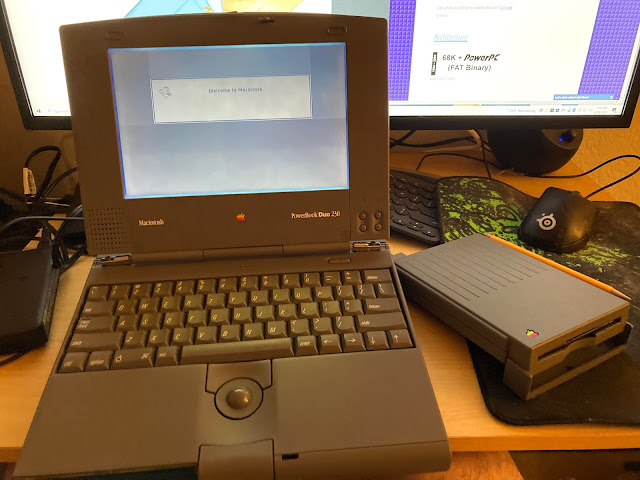Thus far, I have found System 7 rather interesting.
On the PowerBook Duo 230 AKA 30 year old Mac, I’ve got 7.5 running off a BlueSCSI mounted internally. Tech by Androda has a PowerBook configuration that comes with a lovely 3D printed bracket, which was easily mounted using the rails bolted to the original Quantum drive. The only real problem that I had was initializing the drive, in the end I opted to download a prepared blank image. As far as I can tell the difference versus dd’ing my own is Apple Partition Map, Eventually I need to find a nice disk utilities package that fits on a floppy, as the Disk Utils disk offers me little value beyond it boots and has a system folder.
Installing was fairly straight forward since I was able to build floppies using the PowerBook G3 AKA 20 year old Mac. No idea of how, but disk one appears to be bootable but ha sno system folder visible like the Disk Utils disk. The installer however kind of sucks. Attempting an easy install takes about 20 – 40 minutes of swapping 7 floppies, and then dies and deletes the entire staging area off the disk. So I went about doing a custom install piece by piece and determined that its the Apple Guide on diskette 7 that causes this. Also for some reason it follows a pattern of eject disk 1, ask for disk n, eject and ask for disk 1, eject and ask for disk n; whenever I first start installing some item from custom install. Making this whole process a pain in the ass. Once in a while it decided to want to floppies at once. So, while I kind of love how easy it is to get classic Mac OS to boot: I think the 7.5 installer sucked. It is however quite simple and easy to use, if you can get it to work :P. At 7 floppies plus a Disk Utils, it’s not too large a set either.
Beyond that however, it works superbly and for a machine old enough to have school aged children of its own, I find the Duo 230 quite snappy. The real pain was trying to get Stuffit Expander loaded, since getting the images to mount on my G3 was mostly an exercise in futility. Once I finally got the disk made, I both set the write protect tab and wrote a message about not losing the disk because it’s a pain to build. When I was putzing with Basillisk II on my OpenBSD machine it was fairly painless because I could just mount the image directly. In System 9.2.2, I ended up using grabbing the Virtual DVD-ROM/CD Utility off Macintosh Garden. Disk Copy and ShrinkWrap told me to eff myself. Trying to mount in Toast just froze the G3 such that not even the mouse could move. Never liked Roxio on Windows, and don’t think I care for it on Mac either. Needless to say I wasn’t happy getting StuffIt Expander onto my Duo!
One thing that remains to be determined is whether or not I care to migrate to System 7.5.5, or a larger internal image.
Testing 7.5.3 -> 7.5.5 in the emulator was a fairly painless experience. Give or take that it takes forever to unstuff large files compared to my Duo. The StuffIt archive is 70~80 meg. More general stuff in the emulator seems to suggest 7.5.3 improved performance on 68k processors, not just on the younger PowerPC processors. But overall seems less important without a PPC based Mac. Given the size is something like net install + 19 floopies + 3 update floppies, I’ll probably defer that until I have a working RaSCSI where I can just place the files rather than imaging a ton of diskettes.
Regarding the disk images, I’m less decided. I chose to setup BlueSCSI with a 250 MB image. Partly because I just wanted to see it work, and partly because I intend to have RaSCSI be an external drive to shuffle between systems. Considering the Duo came with a dead 160 MB drive and they apparently were sold in 80 MB and 120 MB configurations, I’d like to think 250 MB is a nice balance between the hardware’s era and large enough not to care. Between system folder, basic software, and copies of the floppy loaded setup files, I’m only using about 30 MB. I plan for RaSCSI to present a large 4 GB volume, possibly several; but I could just as easily use that internally.
One oddity: the maximum date. Despite HFS having a limit of 2040 for its max date, I couldn’t go past 2019 without the date wrapping around to 2019 in the control panel. Apparently this was a bug in the date/time control panel, and someone wrote a nifty control panel app that lets you set the date correctly.


